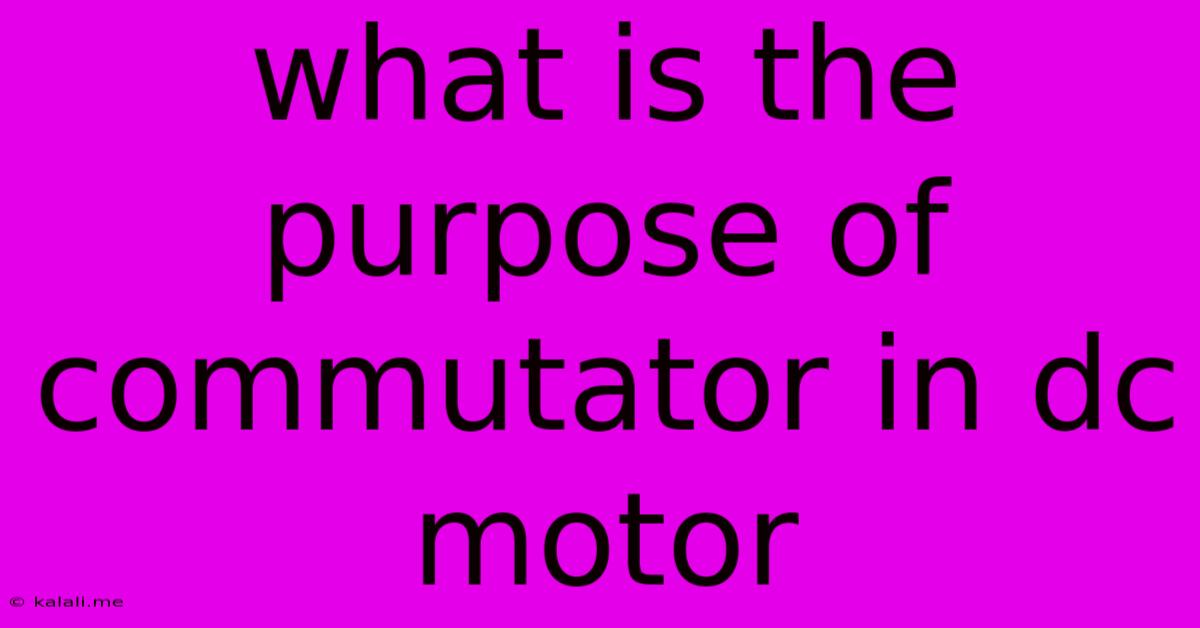What Is The Purpose Of Commutator In Dc Motor
Kalali
Jun 14, 2025 · 3 min read

Table of Contents
The Crucial Role of the Commutator in DC Motors: Ensuring Continuous Rotation
The DC motor, a cornerstone of countless applications from power tools to electric vehicles, relies on a clever mechanism to convert electrical energy into continuous rotational motion. This mechanism is the commutator, a vital component that often gets overlooked despite its critical function. This article will delve into the purpose of the commutator in a DC motor, explaining its operation and significance in maintaining unidirectional torque.
The commutator's primary purpose is to reverse the direction of current flow in the armature winding at precisely the right moments. This seemingly simple action is what enables the continuous rotation of the DC motor. Without it, the motor would only experience jerky, oscillatory movement, failing to achieve sustained rotation. Let's explore why this is the case.
Understanding the Principles of DC Motor Operation
A DC motor operates based on the fundamental principle of electromagnetism: a current-carrying conductor placed within a magnetic field experiences a force. In a DC motor, the armature winding acts as that conductor, and the magnetic field is generated by the field magnets. The interaction between the magnetic field and the current in the armature winding produces torque, causing the rotor to turn.
However, if the current flows consistently in the same direction in the armature winding, the torque would reverse direction every half-rotation. The armature would oscillate back and forth instead of spinning smoothly. This is where the commutator steps in to resolve this issue.
The Commutator: A Mechanical Rectifier
The commutator is essentially a rotating switch composed of segmented copper conductors. These segments are insulated from each other and are connected to the ends of the armature windings. As the rotor spins, the commutator segments make and break contact with the stationary carbon brushes, reversing the current flow in the armature winding at precisely the timed intervals.
This process is similar to a mechanical rectifier, ensuring that the current always flows in a direction that produces torque in the same rotational sense. The precise timing is crucial; if the commutation is not perfectly timed, the motor will experience sparking and reduced efficiency.
The Commutation Process: A Step-by-Step Explanation
-
Initial Current Flow: Current flows through the brushes and into a segment of the commutator, energizing a specific coil within the armature winding. This creates a magnetic field that interacts with the field magnet's magnetic field, generating torque.
-
Rotor Rotation: As the rotor rotates, the commutator segments move.
-
Current Reversal: As a segment moves away from the brush, contact is broken, and the current flow is interrupted for an instant. Simultaneously, a new segment makes contact with the brush, reversing the direction of current flow through the armature winding.
-
Continuous Torque: This current reversal is timed precisely such that the torque continues in the same direction, even though the direction of current flow in the individual armature windings is changing. This ensures smooth and continuous rotation of the motor.
Importance of Proper Commutation
Effective commutation is critical for a DC motor's performance and lifespan. Improper commutation can lead to:
- Excessive sparking: This can damage the commutator and brushes, shortening the motor's life.
- Reduced efficiency: Poor commutation wastes energy, reducing the motor's overall efficiency.
- Arcing and overheating: Extreme cases of poor commutation can cause significant damage to the motor windings and other internal components.
In conclusion, the commutator plays an absolutely indispensable role in the operation of a DC motor. Its ability to precisely reverse the current flow in the armature winding allows for the continuous generation of unidirectional torque, making it a fundamental component in converting electrical energy into mechanical rotary motion. Understanding its function highlights the ingenious simplicity and effectiveness of this crucial element within DC motor technology.
Latest Posts
Latest Posts
-
The Most Common Site For Taking A Pulse Is The
Jun 15, 2025
-
Dc To Ac Power Inverter Circuit
Jun 15, 2025
-
What Is The Square Of 65
Jun 15, 2025
-
Lines Of Symmetry In A Parallelogram
Jun 15, 2025
-
Which Of The Following Is Not Part Of Effective Communication
Jun 15, 2025
Related Post
Thank you for visiting our website which covers about What Is The Purpose Of Commutator In Dc Motor . We hope the information provided has been useful to you. Feel free to contact us if you have any questions or need further assistance. See you next time and don't miss to bookmark.